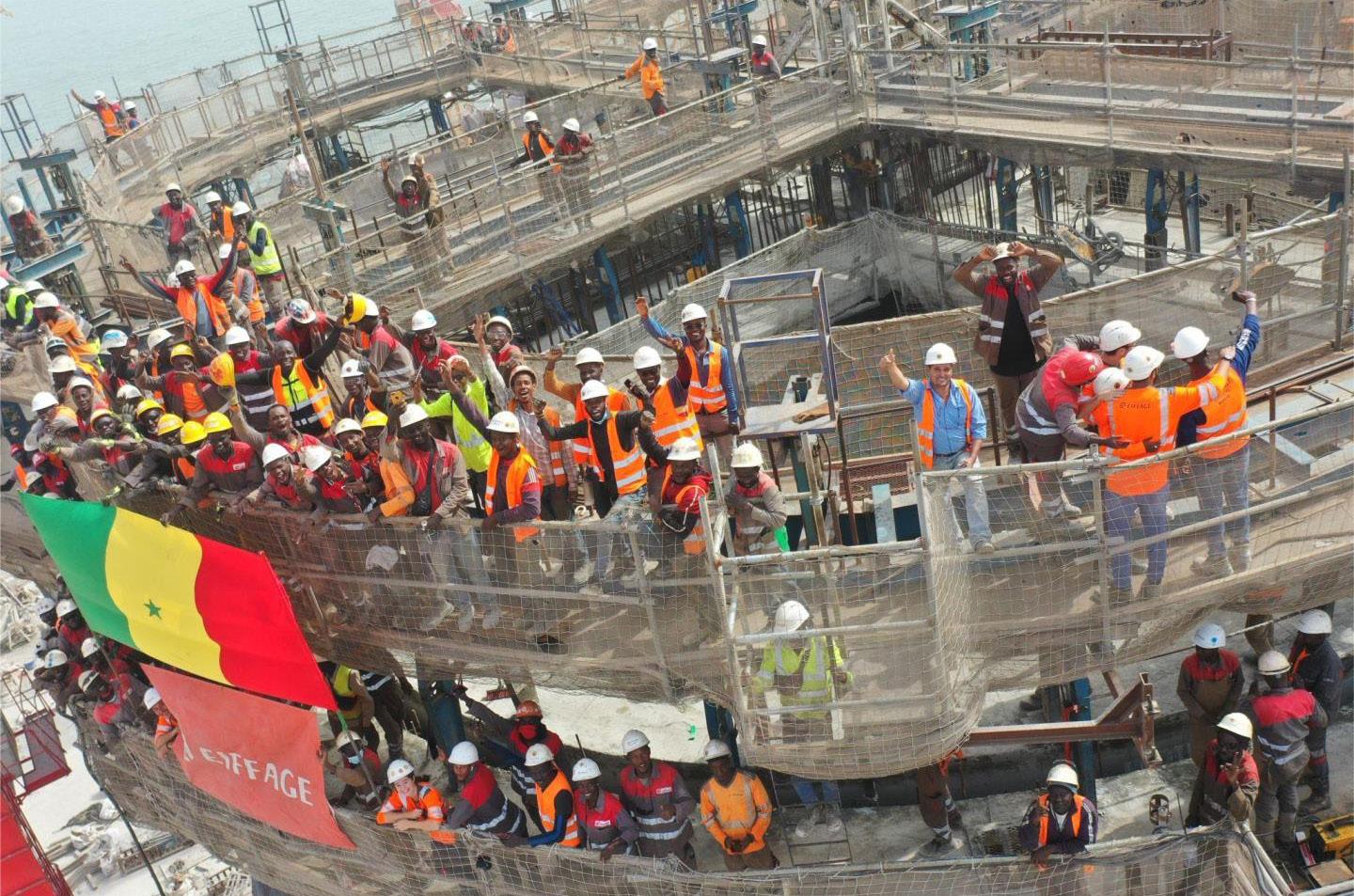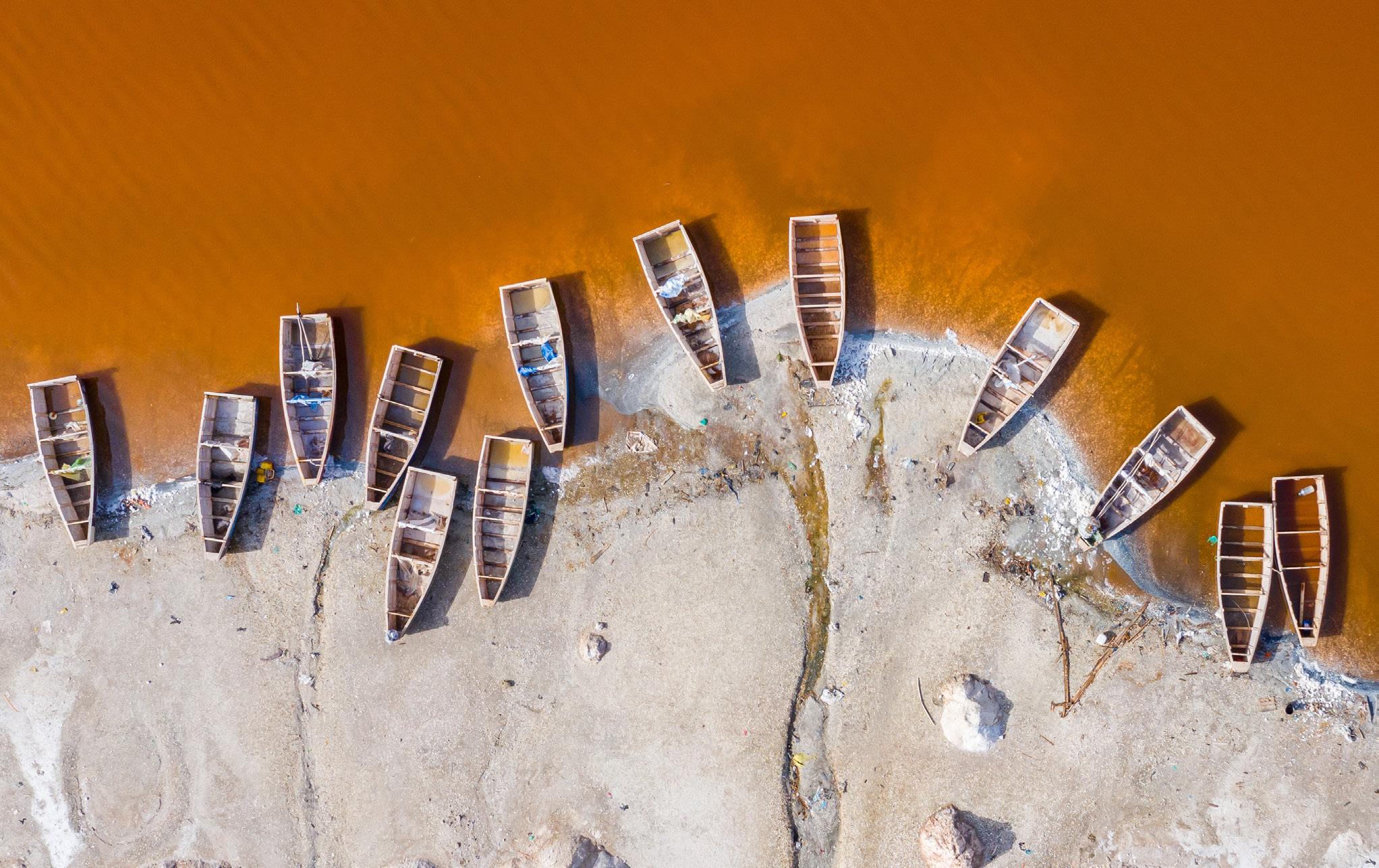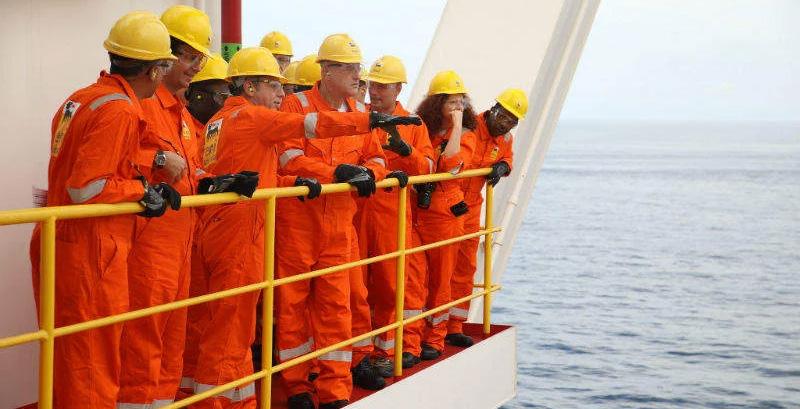
10 minute read
AHMEYIM LNG PROJECT
coasts of Senegal and Mauritania
JOSEPH PHILIPS
Advertisement
Liquefi ed natural gas (LNG) has been universally recognized as a stepping stone in the energy transition. Thanks to its 25% lower carbon emissions than traditional fuels, LNG finds are now usually treated with more fanfare than the discovery of oil wells. It is wholly understandable in this context then, the enthusiasm that surrounds the Greater Tortue Ahmeyim (GTA) LNG project off the coast of Senegal and Mauritania. Between 2014 and 2017, an estimated 15 trillion cubic feet of gas were found in the waters of the two West African nations, a find large enough to justifiably call the region a ‘future hub of world LNG production.’ As the first phase of the project nears completion, Business Excellence decided to provide an overview of a project with the potential to transform the long-term fortunes of the region and the citizens of Senegal and Mauritania.
Overview of the GTA Project
The statistics that define the GTA project confirm that it has the potential to transform West Africa into a new global energy hub. The 15 trillion cubic feet of gas found means that production can continue for at least 30 years. One of the project’s sponsors, bp, believes that extensions of the project could locate up to 100 trillion cubic feet of gas - pushing the region into the top 15 LNG fields in the world. Located around 115 kilometres from the coast of Senegal and Mauritania, phase one of GTA will produce around 2.5 million tonnes of gas per year. The project incorporates a large-bore gas subsea production system (SPS), which is the deepest subsea system installed by bp to date. The investment of bp (60% stake) and its partner on the project, Kosmos (30% stake), in phase one of the project is estimated to have been in the region of $3.6 billion. The national oil companies

Petrosen and SMHPM complete the partnership with a combined 10% stake.
Key Facts
• GTA is a gas project on the maritime border between Mauritania and Senegal.
• The field is located 120 kms offshore, in a water depth of 2850m, the deepest subsea infrastructure in Africa.
• Phase 1 is the first step in establishing the basin as a world-class gas province and major LNG Hub.
• It is set to produce around 2.5 million tonnes of LNG per year.
• Phase 1 is designed for over 20 years of production, with the potential to extend.
• It is granted the status of National Project of Strategic Importance by the Presidents of Mauritania and Senegal.
• The subsea network includes 310km of linepipe, 91km of controls umbilicals, 80km of fibre optic cables and over 100 fabricated structures connecting the wells to the FPSO and then to the Hub.
Milestones Achieved
In February 2022, a major milestone was reached on the road to delivering the first phase of GTA: a breakwater comprised of 21 concrete caissons - totaling 340,000 tonnes - was completed. Each of the caissons weighs more than 16,200 tonnes, with a length of 55 meters, a width of 28 metres, and 28 metres in height. The breakwater is crucial as its will protect the project’s key infrastructure - the floating LNG vessel, its utilities, and accommodation - from the Atlantic.
The completion of the breakwater at GTA also frees up the team behind construction to start pipe rack outfitting and equipment installation and testing. As of May 2022, the project is approximately 75% complete, with mooring piles for the floating production storage and offloading already installed off shore and the vessel itself undergoing dry tests in the shipyard. The hub terminal is also on schedule, and drilling on top holes has been completed on two of the four initial wells. In short, everything is on track for the first gas in the latter half of 2023.
Overcoming COVID-19
The fact that the project is being delivered over a year after the initially planned deadline is a consequence of Covid-19, although perhaps in a more roundabout fashion than you might expect. In mid2021, the project’s FPSO suffered a 3-month delay owing to labour shortages at the COSCO yard in China, where it was being constructed. When work resumed, further delays - albeit ones that the project sponsors were happy to digest - occurred as bp and Kosmos insisted on the highest standards of safety and sanitation possible.
Broad Impact

Our company AMC Travaux, is specialized in providing outsourcing services and local content in the fields of Oil & Gas, energy, construction, mining, and infrastructure. We have highly contributed to the development of the GTA Project


By 2026, Mauritania will have a total production capacity of 10 million tons of LNG annually GTA is expecte d to produce 2.5 million tons of liquefied gas annually after the first phase. Moreover, The follow-up BirAllah project is expected to contribute to doubling Mauritania's gas reserves six times, given the presence of more than 50 trillion cubic feet in this project. With these discoveries Mauritania will be able to partially compensate the dependence of European countries on Russian gas that is affec ted by the Russia-Ukraine war.
AMC Travaux has benefited from working with the GTA project and we are focusing on training our employees working in the field of Oil & Gas to perform well with all due respect to HSE standards
With the support of Oil & Gas project stakeholders in Mauritania, we are willing to continue to develop the skills of our employees and encourage them to face upcoming significan t projects in Mauritania such as BirAllah Gas project and hydrogen projects within the next decades.
Beyond our motivation to make profit and to contribute to the development of local content, we believe that we are responsible as human beings to preserve our planet for future generations by contributing to the big shift of energy resources in order to help the world meet its commitment within the COP2 1 agreement signed in Paris.
What scale of impact does this promise? Immense. It’s also worthwhile to emphasize that bp and Kosmos bring significant combined experienced in maximizing the impact of projects like GTA in region which they domiciled. Before the project has even started, it has initiated a series of community engagement program in both Mauritania and Senegal. Consultation with community leaders regarding how the project will and can impact the communities from a socio-economic and environmental perspective has led to programmes including that in St. Louis, Senegal, where local women received training in fish processing and a “mobile education” programme that has contributed over 1300 equipment and benefited over 8000 students.
Did you know?
It is granted the status of National Project of Strategic Importance by the Presidents of Mauritania and Senegal giving 49 participants an opportunity to be trained locally and internationally (Forth Valley College in Glasgow, Scotland), developed, and prepared to work safely and compliantly on GTA phase-1 operations over the course of four years. Another 8 masters’ students have also been sponsored by bp to be trained in Malaysia (INSTEP and PETRONAS) as well. These programmes are particularly very important as it helps builds the long term capability required to develop the energy industry in Mauritania and Senegal. A community health program has also been founded. bp has also set up a national technician apprentice programme which is currently

Local content engagement is another important element of this project. Though bp and its parties come with international world class experience the GTA team will be engaging well established providers in the both countries and the region as well. The project supplier portal was developed to encourage local content participation
Over the course of the project life, it is conservatively estimated that GTA can deliver $80-$90 billion in revenues to Senegal and Mauritania. To put this figure in context, in 2020, the combined GDP of both countries was somewhere in the region of $31 billion. So $90 billion over 30 years would mean a boost of around 10% to each of the economies and their populations. To reiterate, these figures are conservative.

What scale of impact does this promise? Immense. It’s also worthwhile to emphasize that bp and Kosmos bring signifi cant combined experience in maximizing the impact of projects like GTA in region which they domiciled. Before the project has even started, it has initiated a series of community engagement programs in both Mauritania and Senegal. Consultation with community leaders regarding how the project will and can impact the communities from a socio-economic and environmental perspective has led to programmes including that in St. Louis, Senegal, where local women received training in fish processing and a “mobile education” programme that has contributed over 1300 equipment and benefited over 8000 students. bp has also set up a national technician apprentice programme which is currently giving 49 participants an opportunity to be trained locally and internationally (Forth Valley College in Glasgow, Scotland), developed, and prepared to work safely and compliantly on GTA phase-1 operations over the course of four years. Another 8 masters’ students have also been sponsored by bp to be trained in Malaysia (INSTEP and PETRONAS) as well. These programmes are particularly
As of May 2022, the project is approximately 75% complete very important as it helps builds the longterm capability required to develop the energy industry in Mauritania and Senegal. A community health program has also been founded. their interest directly with bp, learn to participate, and enhance competitiveness; and allows bp’s global procurement practitioners to use it as a source for potential suppliers.
On the environmental side, GTA also brings clean energy to Senegal and Mauritania. As of 2022, only around 60% of their combined populations have access to electricity, and less still clean access to fuels for cooking. The GTA project will not only give them a level of energy independence that they haven’t known before but also give both countries the revenues from millions of tonnes of gas exports every year, fuelling the west of

Africa with a much cleaner fuel than many had been using till now.
Suppliers and Partners

When an O&G major like bp and a highly respected partner firm like Kosmos seek out partners to work on a project like GTA, there are generally no shortage of takers. Such was the case here. The team was able to call in expertise from the likes of Petrofac, who have developed operational procedures for GTA 1, Technip Energies, a newly-formed French company that delivered the project’s FPSLO, and Havfram, a Norwegian sub-contractor of Technip’s that provided pre-installation and hook up of the subsea mooring system for the FPSO.,
The huge task of constructing the 21 mega caissons was delegated to Eiffage Génie Civil, a French engineering team that built the caissons on two Dakar sites, bringing in more than 130,000 m3 of concrete and
30,000 tonnes of steel. Its subcontractor, AMC Travaux, ensured a constant supply of rocks from a Senegalese quarry over two years, which were then used in the project’s breakwater. The subsequent construction of the jetty was delivered by the Fugro.
The fact that there were so many moving parts - and as mentioned, some delayed owing to Covid-19 - demanded plenty of multinational collaboration. Other participants who merit mention in this category include Eurogrues Afrique, Amaranth - which delivered multiple orders of centrifugal pumps for the FPSO, Nexans, and Keppel Offshore and Marine. Last but certainly not least, AMOG is supporting bp on the project’s rise verification system.
Local and regional suppliers and subcontractors were also engaged across board both countries through the project supplier portal.
The Future
The world is a different place in 2022 to the one that the team behind GTA faced when this project first got moving in 2016. Post-covid, new issues seemingly appear on an ongoing basis: war and rising inflation among them. The positive news for this corner of Africa is that LNG is a fuel with a guaranteed long-term future, and that means revenue streams and energy security for both countries for decades to come. For the world, GTA represents a new energy hub. For Senegal and Mauritania, it represents a new horizon.
Zohr Gas
Turning Point for Egyptian
Zohr Gas Field
Egyptian Prosperity
Given the enormous mineral resources in the Middle East in countries such as Saudi Arabia and the UAE, it may surprise some to learn that the first major hydrocarbon producer in the region was Egypt. The country’s oil production goes as far back as the second half of the 19th century, at a time when it was both energy self-sufficient and an exporter of hydrocarbons. Even today, oil and gas production is the single largest economic activity in the country.
Italian energy giant ENI has a presence in the country for over 60 years. Its work with the government of that time has since provided a blueprint for several oil producing countries on how to work with foreign companies. Its 2015 discovery of the Zohr field - the largest ever gas discovery in the Mediterranean - was a boon for the country and its people. Business Excellence decided to take a closer look a find that points to a far more prosperous future for Egypt.
Overview
ENI’s Zohr finding in 2015 is remarkable not simply because of the scale of the fi nding, but because of its historical context. In March of that year, the country’s government announced that it would no longer be energy self-suffi cient owing to a booming population and dwindling supplies. For a country that prides itself on its oil and gas industry’s heritage, it was a hit: The benchmark stock index, the
EGX30 fell by around 30%, as investors got the news.
Just six months later, ENI had discovered Zohr – roughly translated to be “A Muslim prayer offered to God at the noon hour of the morning”. ENI capitalising in on a bet that saw it raise $70 million to fund the exploration in a territory that Royal Dutch Shell had previously drilled for 10 years without success. Little wonder that ENI’s CEO at the time, Claudio Descalzi, referred to the find as “a very emotional moment.”
Prime Minister Mostafa Madbouly also shared similar emotions stating “Before operating this field, we were importing natural gas. The Zohr field enabled Egypt to meet its domestic needs and achieve an export surplus” In addition to bringing Egypt back to energy self-sufficiency, the success of the Zohr fields has reignited global oil industry interest in the country.

The Zohr field itself is spread over approximately 100km2 within the offshore Shorouk Block, nearly 200km from Port Said, Egypt. The water depth in the field area is 1,500 metres and its reservoir extends for a further 4,000 metres below the sea bed. In total, Zohr is estimated to contain around 30 trillion cubic feet (Tcf) of recoverable gas reserves, providing enough gas for Egypt for over 20 years.
Egypt for over 20 years.
In terms of the on-site infrastructure, the










